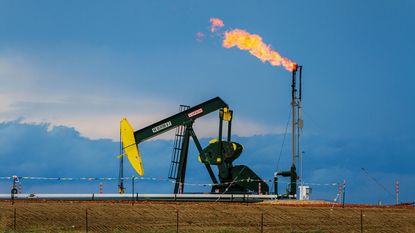The oil-price rebound has stalled
The post-lockdown rally in the oil price has now stalled, with prices down by 6% since the beginning of September

Are we heading for another oil-price slump? Benchmark Brent crude futures plunged to an 18-year low of around $19 a barrel in April, while US oil futures briefly went negative. Prices have since climbed out of the lockdown hole, with Brent trading around $45 a barrel over the summer. Yet the rally has now stalled, with prices down by 6% since 1 September to about $42.50 a barrel.
Global demand for oil is wobbly. A second wave of Covid-19 will see more people working from home, while lapsing government support programmes make for a shakier outlook for consumption and global trade. Global crude oil demand was roughly 100 million barrels per day (mbpd) in 2019, but is likely to be closer to 90 mbpd this year, according to forecasts by oil-exporters’ cartel Opec. In Japan, the world’s fourth-biggest crude importer, imports fell by more than 25% on the year in August, says Bozorgmehr Sharafedin in Reuters.
Bulls are looking to the supply side. The price crash has battered US shale oil, says Myles McCormick in the Financial Times. Upstream energy firms with a combined $85bn of debt have filed for bankruptcy protection over the last eight months. Many investors are “fed up” with the unprofitable sector and won’t bankroll further losses. US oil output peaked at 13 mbpd at the start of this year, but is currently below 11 mbpd says the Energy Information Administration.
Subscribe to MoneyWeek
Subscribe to MoneyWeek today and get your first six magazine issues absolutely FREE

Sign up to Money Morning
Don't miss the latest investment and personal finances news, market analysis, plus money-saving tips with our free twice-daily newsletter
Don't miss the latest investment and personal finances news, market analysis, plus money-saving tips with our free twice-daily newsletter
Oil-Price War Two?
Yet reduced output will only gradually make a dent in the world’s swollen stockpiles. Countries such as China used the April price crash as an opportunity to fill up the national tank at a bargain price. Global inventories remain above historic levels and “spare capacity” in the supply chain is “at the highest levels in 25 years”, says Steve Goldstein in Barron’s.
April’s oil-price crash was triggered by a Saudi-Russian “price war”. Unable to agree on how to manage slumping demand amid the first wave of lockdowns, the two sides resorted to flooding the market with crude in an all-out effort to win market share.
After the price war, however, Opec+, a grouping led by Saudi Arabia and Russia, got its act together, cutting collective output by 9.7 mbpd in April compared with 2018 output levels. That move stabilised the market. Those cuts are being reduced, but still stand at 7.7 mbpd. Could we be in for a repeat performance? Riyadh and Moscow are split over how to manage the latest demand hit, says Julian Lee on Bloomberg. Russia prefers to wait and see, but the Saudis have called for a more “proactive and preemptive” approach that favours new cuts to keep prices buoyant. This is all strikingly similar to what happened in March. Don’t rule out “another showdown before the end of the year”.
-
 Private school fees soar and VAT threat looms – what does it mean for you?
Private school fees soar and VAT threat looms – what does it mean for you?Rising private school fees could see more than one in five parents pull their children out of their current school. Before you remortgage, move house or look to grandparents for help, here’s what you need to know.
By Katie Williams Published
-
 Best and worst UK banks for online banking revealed
Best and worst UK banks for online banking revealedWhen it comes to keeping your money safe, not all banks are equal. We reveal the best and worst banks for online banking when it comes to protecting your money from scams
By Oojal Dhanjal Published
-
 AstraZeneca CEO’s £1.8mn pay rise approved despite shareholder opposition
AstraZeneca CEO’s £1.8mn pay rise approved despite shareholder oppositionAstraZeneca hiked its dividend to persuade shareholders to accept CEO Pascal Soriot’s pay rise. Is he worth his salary?
By Dr Matthew Partridge Published
-
 Adidas, Nike or Jordans - could collectable trainers make you rich?
Adidas, Nike or Jordans - could collectable trainers make you rich?The right pair of trainers can fetch six figures. Here's how you can start collecting vintage Adidas, Nike or Jordans now
By Chris Carter Published
-
 The industry at the heart of global technology
The industry at the heart of global technologyThe semiconductor industry powers key trends such as artificial intelligence, says Rupert Hargreaves
By Rupert Hargreaves Published
-
 Three emerging Asian markets to invest in
Three emerging Asian markets to invest inProfessional investor Chetan Sehgal of Templeton Emerging Markets Investment Trust tells us where he’d put his money
By Chetan Sehgal Published
-
 What to consider before investing in small-cap indexes
What to consider before investing in small-cap indexesSmall-cap index trackers show why your choice of benchmark can make a large difference to long-term returns
By Cris Sholto Heaton Published
-
 Why space investments are the way to go for investors
Why space investments are the way to go for investorsSpace investments will change our world beyond recognition, UK investors should take note
By Merryn Somerset Webb Published
-
 Time to tap into Africa’s mobile money boom
Time to tap into Africa’s mobile money boomFavourable demographics have put Africa on the path to growth when it comes to mobile money and digital banking
By Rupert Hargreaves Published
-
 M&S is back in fashion: but how long can this success last?
M&S is back in fashion: but how long can this success last?M&S has exceeded expectations in the past few years, but can it keep up the momentum?
By Rupert Hargreaves Published